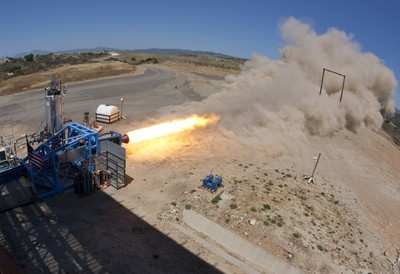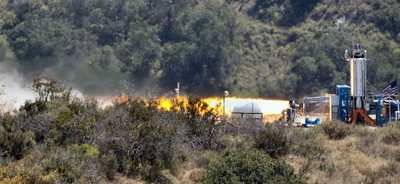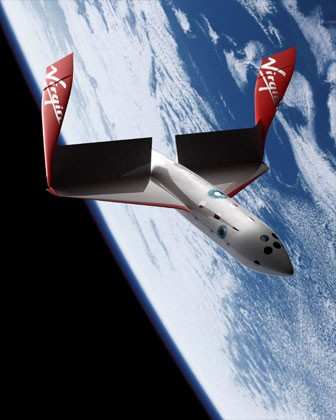Fri, May 29, 2009
Flight Tests Scheduled For Late '09
 In the desert of southern
California, Virgin Galactic’s key supplier, Scaled
Composites, and its subcontractor SNC (Sierra Nevada Corporation)
have successfully completed the first tests of the innovative
rocket motor that will propel space tourists, scientists and
payloads into space. The hybrid Nitrous Oxide system being used is
the largest of its kind in the world and it will send
Virgin’s customers up into sub-orbital space at speeds over
2500 mph, to heights over 65 miles above the Earth’s surface,
before the spaceship descends back down through the atmosphere
using its pioneering feathered re-entry system.
In the desert of southern
California, Virgin Galactic’s key supplier, Scaled
Composites, and its subcontractor SNC (Sierra Nevada Corporation)
have successfully completed the first tests of the innovative
rocket motor that will propel space tourists, scientists and
payloads into space. The hybrid Nitrous Oxide system being used is
the largest of its kind in the world and it will send
Virgin’s customers up into sub-orbital space at speeds over
2500 mph, to heights over 65 miles above the Earth’s surface,
before the spaceship descends back down through the atmosphere
using its pioneering feathered re-entry system.
Sir Richard Branson, founder of Virgin Galactic said: “As
Virgin Galactic gets ever closer to the start of commercial
operations, we are reaching and passing many important and historic
milestones. The Virgin MotherShip (VMS) Eve, the first of our
amazing, all carbon composite, high altitude WhiteKnightTwo launch
vehicles, is flying superbly. SpaceShipTwo, which will air launch
from Eve, is largely constructed and awaiting the start of its own
test flight program later this year.”
The rocket motor burns for a very short period of time because
the spaceship is launched from VMS Eve in the upper atmosphere,
rather than from ground level. This means much less fuel is
required, and the fuel burn is more environmentally benign than the
solid rockets used in most ground based systems.

While the rocket motor is extremely powerful, it is also completely
controllable. This system can - if necessary - be shut down at any
time, allowing the spaceship to glide back down to land at a
conventional runway. This is a significant feature in the overall
safety of the Virgin system for human space flight.

Sir Richard continues: “Less fuel and clean fuel all add
up to a space launch system which will be completely unprecedented
in its low environmental impact compared with current space flight.
The spaceship’s carbon footprint for each of its passengers
and crew will be about a quarter of that for a return trip from
London to New York."

The rocket motor will continue a series of exhaustive tests, and
the spaceship itself will start flight testing later this year.
More News
With Testing Soon Complete, Launch Preparations Begin in Earnest Sierra Space's Dream Chaser has been put through the wringer at NASA's Glenn Armstrong Test Facility in Ohio, but w>[...]
Takeoff Roll The process whereby an aircraft is aligned with the runway centerline and the aircraft is moving with the intent to take off. For helicopters, this pertains to the act>[...]
“We’re proud of the hard work that went into receiving this validation, and it will be a welcome relief to our customers in the European Union. We couldn’t be mor>[...]
"Aircraft Spruce is pleased to announce the acquisition of the parts distribution operations of Wag-Aero. Wag-Aero was founded in the 1960’s by Dick and Bobbie Wagner in the >[...]
IDENT Feature The special feature in the Air Traffic Control Radar Beacon System (ATCRBS) equipment. It is used to immediately distinguish one displayed beacon target from other be>[...]
 Sierra Space Repositions Dream Chaser for First Mission
Sierra Space Repositions Dream Chaser for First Mission ANN's Daily Aero-Term (05.10.24): Takeoff Roll
ANN's Daily Aero-Term (05.10.24): Takeoff Roll Aero-News: Quote of the Day (05.10.24)
Aero-News: Quote of the Day (05.10.24) Aero-News: Quote of the Day (05.11.24)
Aero-News: Quote of the Day (05.11.24) ANN's Daily Aero-Term (05.11.24): IDENT Feature
ANN's Daily Aero-Term (05.11.24): IDENT Feature






